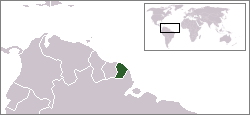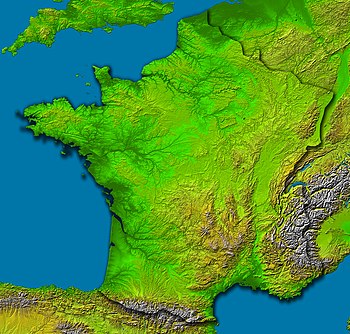Geography of France
From Wikipedia, the free encyclopedia.
Contents |
Location
Western Europe, bordering the Bay of Biscay and English Channel, between Belgium and Spain, southeast of the UK; bordering the Mediterranean Sea, between Italy and Spain.
Geographic coordinates: 46°00′ N 2°00′ E
Area
total: 674,843 km²
note: whole territory of the French Republic, including all the overseas departments and territories, but excluding the French territory of Terre Adélie in Antarctica where sovereignty is suspended since the signing of the Antarctic Treaty in 1959
metropolitan France: 551,695 km²
note: metropolitan (i.e. European) France only, French National Geographic Institute data
metropolitan France: 543,965 km²
note: metropolitan (i.e. European) France only, French Land Register data, which exclude lakes, ponds, and glaciers larger than 1 km² as well as the estuaries of rivers
Boundaries
Land boundaries:
total: 2,889 km (metropolitan), 1,183 km (French Guiana), 10.2 km (Guadeloupe)
border countries: Andorra 56.6 km, Belgium 620 km, Germany 451 km, Italy 488 km, Luxembourg 73 km, Monaco 4.4 km, Spain 623 km, Switzerland 573 km, Brazil 673 km, Suriname 510 km, Netherlands Antilles 10.2km
Coastline: 3,427 km (metropolitan), 378 km (French Guiana), 306 km (Guadeloupe), ??? km (other DOMs/TOMs)
Maritime claims:
contiguous zone: 24 nautical miles (44 km)
continental shelf: 200-m depth or to the depth of exploitation
exclusive economic zone: 200 nautical miles (370 km) does not apply to the Mediterranean
territorial sea: 12 nautical miles (22 km)
Internal Divisions
Main article: Administrative divisions of France
Metropolitan (i.e. European) France is divided into 22 régions (although strictly speaking Corsica is in fact a territorial collectivity, not a région, but is referred to as a region in common speech), which are subdivided into 96 départements, which are further divided into 329 arrondissements, which are further divided into 3,879 cantons, which are further divided into 36,568 communes (as of 1.1.2004).
The French Republic is further made up of the following overseas divisions:
- 4 overseas regions (régions d'outre-mer, or ROM): Guadeloupe, French Guiana, Martinique, and Réunion, which have the same status as metropolitan regions (as much as Hawaii has the same status as a continental US state), each of these overseas regions also being an overseas département (département d'outre-mer, or DOM), with the same status as a département of metropolitan France. This double structure (région/département) is new, due to the recent extension of the regional scheme to the overseas départements, and may soon transform into a single structure, with the merger of the regional and departmental assemblies, unless new départements are created such as in the case of Réunion, where it has been proposed to create a second département in the south of the island, with the région of Réunion above these two départements.
- 3 overseas collectivities (collectivités d'outre-mer, or COM): Saint-Pierre and Miquelon, Wallis and Futuna, and Mayotte (although strictly speaking Mayotte is in fact a "departmental collectivity", not an overseas collectivity, with the possibility to become a full-status French département in 2010, but for the sake of clarity it is most often classified as overseas collectivity)
- 1 sui generis collectivity (collectivité sui generis): New Caledonia, whose status is unique in the French Republic
- 1 overseas "country" (pays d'outre-mer, or POM): French Polynesia
- 1 overseas territory (territoire d'outre-mer, or TOM): the French Southern and Antarctic Lands
- 5 islands in the Indian Ocean with no permanent population and known as Îles Éparses ("Scattered Islands"), which are administered by the prefect of the département of Réunion: Bassas da India, Europa, Juan de Nova, Glorioso, and Tromelin
- 1 uninhabited island in the Pacific Ocean off the coast of Mexico which is administered by the high-commissioner of the French Republic in French Polynesia: Clipperton
Climate
The Climate is generally one of cool winters and mild summers, with mild winters and hot summers along the Mediterranean. There is a lot of regional variation, however, and in the southwest of France, for example, summers are generally hot inland south of the Dordogne river.
Terrain
Mostly flat plains or gently rolling hills in north and west; remainder is mountainous, especially Pyrenees in south, Alps in east.
Elevation extremes:
lowest point: Rhone River delta -2 m
highest point: Mont Blanc 4,808 m
Natural resources
coal, iron ore, bauxite, fish, timber, zinc, potash
Land use
arable land: 33%
permanent crops: 2%
permanent pastures: 20%
forests and woodland: 27%
other: 18% (1993 est.)
Irrigated land: 16,300 km² (1995 est.)
Natural hazards
Environment
Environment - current issues: some forest damage from acid rain (major forest damage occurred as a result of severe December 1999 windstorm); air pollution from industrial and vehicle emissions; water pollution from urban wastes, agricultural runoff
Environment - international agreements:
party to: Air Pollution, Air Pollution-Nitrogen Oxides, Air Pollution-Sulphur 85, Air Pollution-Sulphur 94, Air Pollution-Volatile Organic Compounds, Antarctic-Environmental Protocol, Antarctic Treaty, Biodiversity, Climate Change, Desertification, Endangered Species, Hazardous Wastes, Law of the Sea, Marine Dumping, Marine Life Conservation, Ozone Layer Protection, Ship Pollution, Tropical Timber 83, Tropical Timber 94, Wetlands, Whaling
signed, but not ratified: Air Pollution-Persistent Organic Pollutants, Climate Change-Kyoto Protocol
Geography - note: largest West European nation; occasional strong, cold, dry, north-to-northwesterly wind known as mistral
Cities and towns include
Cities and major towns or those of historical significance include:
Abbeville, Ajaccio, Albertville, Albi, Amiens, Angers, Angouleme, Aurillac, Bastia, Besançon, Bordeaux, Belfort, Brest, Brive, Caen, Cahors, Calais, Cannes, Carcassonne, Chamonix, Charleville-Mezieres, Chatellerault, Chinon, Clermont-Ferrand, Colmar, Deauville, Dieppe, France, Digne-les-Bains, Dijon, Dole, Domremy, Dreux, Dunkerque, Evreux, Grenoble, La Baule, La Rochelle, Le Havre, Lille, Lyon, Marseille, Mende, Metz, Mont-de-Marsan, Montauban, Montpellier, Nantes, Nice, Nimes, Orléans, Paris, Pau, Perigueux, Perpignan, Poitiers, Quimper, Reims, Rennes, Rodez, Roubaix,Rouen, Saint-Gaudens, Saint-Etienne, Saint-Nazaire, Saint-Tropez, Saumur, Sete, Soissons, Strasbourg, Tarbes, Toulon, Toulouse, Tours, Tourcoing, Valence, Vichy
Picture from space
This image of metropolitan France was generated with data from the Shuttle Radar Topography Mission (SRTM). For this broad view the resolution of the data was reduced, resampled to a Mercator projection and the French border outlined. The variety of landforms comprising the country is readily apparent.
The upper central part of this scene is dominated by the Paris Basin, which consists of a layered sequence of sedimentary rocks. Fertile soils over much of the area make good agricultural land. The Normandie coast to the upper left is characterized by high, chalk cliffs, while the Brittany coast (the peninsula to the left) is highly indented where deep valleys were drowned by the sea, and the Biscay coast to the southwest is marked by flat, sandy beaches.
To the south, the Pyrenees form a natural border between France and Spain, and the south-central part of the country is dominated by the ancient Massif Central. Subject to volcanism that has only subsided in the last 10,000 years, these central mountains are separated from the Alps by the north-south trending Rhone River Basin.
Two visualization methods were combined to produce the image: shading and color coding of topographic height. The shade image was derived by computing topographic slope in the northwest-southeast direction, so that northwest slopes appear bright and southeast slopes appear dark. Color coding is directly related to topographic height, with green at the lower elevations, rising through yellow and tan, to white at the highest elevations.
Elevation data used in this image were acquired by the Shuttle Radar Topography Mission aboard the Space Shuttle Endeavour, launched on Feb. 11, 2000. SRTM used the same radar instrument that comprised the Spaceborne Imaging Radar-C/X-band Synthetic Aperture Radar (SIR-C/X-SAR) that flew twice on the Space Shuttle Endeavour in 1994. SRTM was designed to collect 3-D measurements of the Earth's surface. To collect the 3-D data, engineers added a 60-meter (approximately 200-foot) mast, installed additional C-band and X-band antennas, and improved tracking and navigation devices.
- Location: 42 to 51.5 ° North, 5.5 West to 8 ° East.
- Orientation: North toward the top, Mercator projection.
- Image Data: shaded and colored SRTM elevation model.
- Original Data Resolution: 1 arcsecond (~30 meters).
- Date Acquired: February 2000.
- Image Courtesy SRTM Team NASA/JPL/NIMA
Extreme points
This is a list of the extreme points of France, the points that are farther north, south, east or west than any other location. Note that collectivités territoriales and pays et territoires d'outre-mer are not included in this list.
France (metropolitan)
- Northernmost Point — Bray-Dunes, Nord
- Southernmost Point — Îles Lavezzi, off Corsica
- Westernmost Point — Île d'Ouessant, off Brittany
- Easternmost Point — near Cervione, Haute-Corse
France (mainland)
- Northernmost Point — Bray-Dunes, Nord
- Southernmost Point — Puig de Comanegra, Pyrénées-Orientales
- Westernmost Point — Pointe de St-Mathieu, Finistère
- Easternmost Point — Lauterbourg, Bas Rhin
France (including départements d'outre mer)
- Northernmost Point — Bray-Dunes, Nord
- Southernmost Point — Saint-Joseph, Réunion
- Westernmost Point — La Pointe-Noire, Guadeloupe
- Easternmost Point — Sainte-Rose, Réunion




